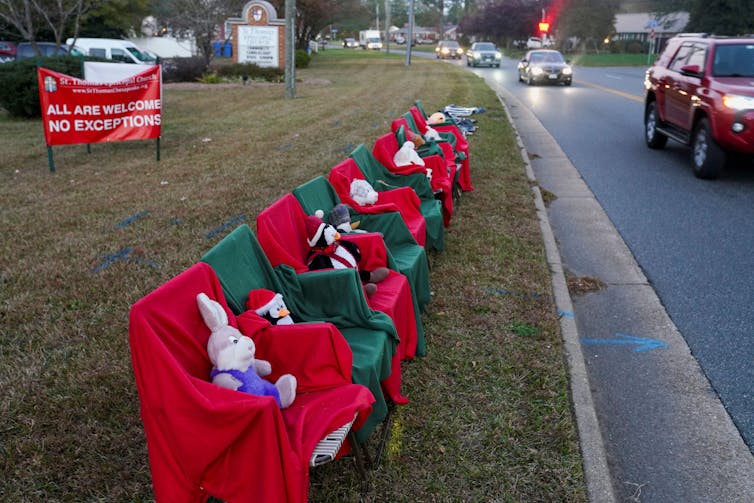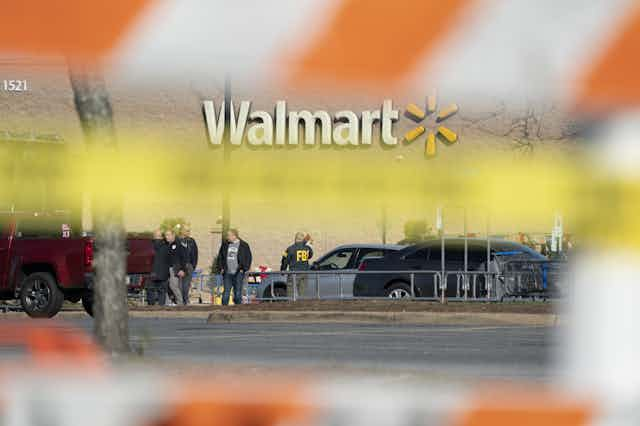At 10.12pm on November 23, an overnight team leader at a Walmart in Chesapeake, Virginia, opened fire on colleagues in the crew room. The 31-year-old perpetrator killed six and injured at least six more before killing himself.
The violence was directed towards fellow workers – no customers were targeted – but it is not yet known if any were targeted specifically. This was the 606th gun attack in the US in 2022 where at least four others were shot in a single incident.
Workplace mass shootings (WMS) are undertaken by attackers who either work or worked for an organisation where the attack occurs. They are different from mass shootings which occur at workplaces unrelated to attackers or where the perpetrators are (disgruntled) customers. WMS have happened in pretty much all sectors in the US: uniformed services, breweries, construction, distribution, offices, software engineering, education and power plants.
Most notoriously, there were several attacks in the 1980s and 1990s on sites operated by the US Postal Service (USPS). More than 20 incidents of “workplace rage” by USPS workers occurred between 1970 and 1997 resulting in more than 60 deaths although the commonly used term “going postal” was effectively debunked when it was found USPS staff were statistically no more likely to commit WMS than staff in other sectors. The most lethal USPS incident was at Edmond, Oklahoma, in 1986, when a disgruntled USPS employee shot and killed 14 colleagues before killing himself.
US workplaces became safer in the 1990s and 2000s – workplace murder rates dropped by 50% over that period. But despite active policing measures, improved workplace security and improvements in public health and social care, workplace mass shootings are increasing.
A study of 44 workplace shootings from 1986-2011 shows such attacks often differ from other public mass shootings. They are rarely racially motivated, they are not motivated by desires for infamy and are rarely committed due to faith or ideology.
Workplace attacks are quite homogeneous in motive. They are mostly attributed to revenge and often derived from attackers’ perceptions of being denied “organisational justice” and being treated unfairly. Figures show that more than half of WMS are perpetrated by current employees with less than 25% of attackers having been in post less than a year. In almost 50% of cases, attackers left employment but returned months later to “settle scores”.
Many other mass shootings occur at commercial premises perpetrated by disgruntled customers or clients, rather than staff. Since 2006 there have been 25 mass shootings at US commercial locations that were not perpetrated by employees or former employees. The US Bureau of Labor Statistics shows that in 2018 alone, 351 people were killed in workplaces by firearms.
FBI data from 2000-13 showed 45% of US mass shootings occurred in commercial premises. That’s nearly twice as many as in schools and campuses (24%). This flies in the face of public perceptions – probably thanks to biases in media coverage – that school shootings are the single biggest type of mass shooting incident.
Data on mass shootings from Mother Jones magazine covering 2006-22 (defining a mass shooting as a minimum of three deaths excluding the shooter, in public places) shows there were 35 WMS in the US, with 214 deaths. This accounts for roughly 26% of the 802 deaths from all mass shootings in the same period. In the same period, there were 152 deaths from 13 school shootings.
Workplace heartbreak
Workplace mass shootings are low-frequency yet highly impacting events that haunt companies and personnel for decades. John Furner, Walmart US president and CEO, said the Chesapeake shooting “was exceptionally tragic because the assailant was an employee. We feel tragedies like this personally and deeply … The entire Walmart family is heartbroken.”

In workplace attacks, victims are generally indiscriminately chosen – although shooters have a bias for targeting people they had grudges with (managers, supervisors, human resources) before widening out to coworkers or customers who may be present. FBI data shows such targeting happens in 60% of WMS cases.
Other studies found attackers to typically be white (70%) and male (95%-97%). Perpetrators were equally likely to be blue-collar or managerial workers, with an average age under 40 years.
Attackers tend to have antisocial tendencies, but they are rarely mentally ill and the vast majority are free from drug or substance misuse habits. Some studies suggest attackers may be uptight “grievance collectors” who find it hard to move on.
FBI records of cases where attacker’s grievances were identified found the most common triggers (in 49% of cases) were interpersonal workplace difficulties, or disciplinary action being taken against the shooters. The data shows the presence of significant acute stressors is common in many shortly before committing their attacks. These often include financial strain, conflicts with friends or family, marital problems and – to a lesser extent – substance misuse, sexual frustration and criminal or civil problems.
Workplace attackers tend not to overarm themselves and take fewer weapons with them compared with other types of attackers – other types of mass shooters often take as many as 11 firearms on their attacks. These killers usually carry an average of three weapons, which means that the resultant injuries and deaths may be lower than in other mass shootings.
But workplace shooters are similar to other mass killers in that they are as likely to display “leakage behaviour” – intentionally or unintentionally giving clues to any feelings that may signal an impending violent act. These are often subtle threats, boasts, innuendos, predictions or ultimatums either in person, via text messages or social media posts. In more than 60% of workplace attacks, at least one other coworker is usually aware of the attacker’s plans.
Mass shootings reached an unprecedented high in 2020 – as did firearm sales. And the precarious nature of employment and perceived economic downturn over the next two years for most economies, means the number of disgruntled and vengeful employees may increase. Worryingly, most workplaces remain soft targets, with little defence against attackers.
Research into the background characteristics of such attackers and the role of workplace interactions in their pathways to violence will help reveal more about this often overlooked classification of mass shooter. But fairer workplaces, where equitable treatment is visible for all staff, will save more working lives than any “run, hide, fight” campaign could possibly do.
Read more: Mass shootings in the US have risen sharply in 2020 – why?

